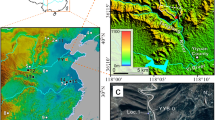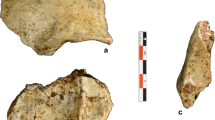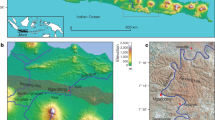Abstract
The stratigraphy at Bacho Kiro Cave, Bulgaria, spans the Middle to Upper Palaeolithic transition, including an Initial Upper Palaeolithic (IUP) assemblage argued to represent the earliest arrival of Upper Palaeolithic Homo sapiens in Europe. We applied the latest techniques in 14C dating to an extensive dataset of newly excavated animal and human bones to produce a robust, high-precision radiocarbon chronology for the site. At the base of the stratigraphy, the Middle Palaeolithic (MP) occupation dates to >51,000 yr bp. A chronological gap of over 3,000 years separates the MP occupation from the occupation of the cave by H. sapiens, which extends to 34,000 cal bp. The extensive IUP assemblage, now associated with directly dated H. sapiens fossils at this site, securely dates to 45,820–43,650 cal bp (95.4% probability), probably beginning from 46,940 cal bp (95.4% probability). The results provide chronological context for the early occupation of Europe by Upper Palaeolithic H. sapiens.
This is a preview of subscription content, access via your institution
Access options
Access Nature and 54 other Nature Portfolio journals
Get Nature+, our best-value online-access subscription
$29.99 / 30 days
cancel any time
Subscribe to this journal
Receive 12 digital issues and online access to articles
$119.00 per year
only $9.92 per issue
Buy this article
- Purchase on Springer Link
- Instant access to full article PDF
Prices may be subject to local taxes which are calculated during checkout



Similar content being viewed by others
Data availability
All data are available in the manuscript and supplementary materials.
Code availability
OxCal script is included in the supplementary information.
References
Garrod, D., Howe, B. & Gaul, J. Excavations in the cave of Bacho Kiro, north-east Bulgaria. Bull. Am. Sch. Prehist. Res. 15, 46–76 (1939).
Kozłowski, J. K. Excavation in the Bacho Kiro Cave (Bulgaria): Final Report (Państwowe Wydawnictwo Naukowe, 1982).
Tsanova, T. Les Débuts du Paléolithique Supérieur dans l’Est des Balkans. Réflexion à Partir de l’Étude Taphonomique et Techno-Économique des En-sembles Lithiques de Bacho Kiro (Couche 11), Temnata (Couches VI et 4) et Kozarnika (Niveau VII) Vol. 1752 (BAR International Series, 2008).
Hublin, J. J. et al. Initial Upper Palaeolithic Homo sapiens remains from Bacho Kiro Cave (Bulgaria). Nature https://doi.org/10.1038/s41586-020-2259-z (2020).
Kuhn, S. L. & Zwyns, N. Rethinking the initial upper Paleolithic. Quat. Int. 347, 29–38 (2014).
Hublin, J. J. The modern human colonization of western Eurasia: when and where? Quat. Sci. Rev. 118, 194–210 (2015).
Sirakov, N. et al. Reopened Bacho Kiro—new data on Middle/Upper Palaeolithic transition and Early-Middle stages of Upper Palaeolithic (Bulgarian Academy of Sciences, 2017).
Hedges, R. E. M., Housley, R. A., Bronk Ramsey, C. & van Klinken, G. J. Radiocarbon dates from the Oxford AMS system: Archaeometry datelist 18. Archaeometry 36, 337–374 (1994).
Bird, M. et al. Radiocarbon dating of ‘old’ charcoal using a wet oxidation, stepped-combustion procedure. Radiocarbon 41, 127–140 (1999).
Wood, R. E. et al. Testing the ABOx-SC method: dating known-age charcoals associated with the Campanian Ignimbrite. Quat. Geochronol. 9, 16–26 (2012).
Brown, T. A., Nelson, D. E., Vogel, J. S. & Southon, J. R. Improved collagen extraction by modified Longin method. Radiocarbon 30, 171–177 (1988).
Bronk Ramsey, C., Higham, T., Bowles, A. & Hedges, R. Improvements to the pretreatment of bone at Oxford. Radiocarbon 46, 155–164 (2004).
Talamo, S. & Richards, M. A comparison of bone pretreatment methods for AMS dating of samples >30,000 bp. Radiocarbon 53, 443–449 (2011).
Higham, T. European Middle and Upper Palaeolithic radiocarbon dates are often older than they look: problems with previous dates and some remedies. Antiquity 85, 235–249 (2011).
Buckley, M., Collins, M., Thomas-Oates, J. & Wilson, J. C. Species identification by analysis of bone collagen using matrix-assisted laser desorption/ionisation time-of-flight mass spectrometry. Rapid Commun. Mass Spectrom. 23, 3843–3854 (2009).
van Klinken, G. J. Bone collagen quality indicators for palaeodietary and radiocarbon measurements. J. Archaeol. Sci. 26, 687–695 (1999).
Wilson, J., van Doorn, N. L. & Collins, M. J. Assessing the extent of bone degradation using glutamine deamidation in collagen. Anal. Chem. 84, 9041–9048 (2012).
Bronk Ramsey, C. Bayesian analysis of radiocarbon dates. Radiocarbon 51, 337–360 (2009).
Reimer, P. J. et al. IntCal13 and Marine13 radiocarbon age calibration curves 0–50,000 years cal bp. Radiocarbon 55, 1869–1887 (2013).
Bronk Ramsey, C. Dealing with outliers and offsets in radiocarbon dating. Radiocarbon 51, 1023–1045 (2009).
Svensson, A. et al. A 60 000 year Greenland stratigraphic ice core chronology. Clim. Past 4, 47–57 (2008).
Cheng, H. et al. Atmospheric 14C/12C changes during the last glacial period from Hulu Cave. Science 362, 1293–1297 (2018).
Staubwasser, M. et al. Impact of climate change on the transition of Neanderthals to modern humans in Europe. Proc. Natl Acad. Sci. USA 115, 9116–9121 (2018).
Nowaczyk, N. R., Arz, H. W., Frank, U., Kind, J. & Plessen, B. Dynamics of the Laschamp geomagnetic excursion from Black Sea sediments. Earth Planet. Sci. Lett. 351-352, 54–69 (2012).
Wegwerth, A. et al. Black Sea temperature response to glacial millennial-scale climate variability. Geophys. Res. Lett. 42, 8147–8154 (2015).
Müller, U. C. et al. The role of climate in the spread of modern humans into Europe. Quat. Sci. Rev. 30, 273–279 (2011).
Giaccio, B., Hajdas, I., Isaia, R., Deino, A. & Nomade, S. High-precision 14C and 40Ar/39Ar dating of the Campanian Ignimbrite (Y-5) reconciles the time-scales of climatic-cultural processes at 40 ka. Sci. Rep. 7, 45940 (2017).
Buizert, C. et al. Abrupt ice-age shifts in southern westerly winds and Antarctic climate forced from the north. Nature 563, 681–685 (2018).
Fu, Q. et al. The genetic history of Ice Age Europe. Nature 534, 200–205 (2016).
Fewlass, H. et al. Size matters: radiocarbon dates of <200 µg ancient collagen samples with AixMICADAS and its gas ion source. Radiocarbon 60, 425–439 (2017).
Fewlass, H. et al. Pretreatment and gaseous radiocarbon dating of 40–100 mg archaeological bone. Sci. Rep. 9, 5342 (2019).
Talamo, S. et al. RESOLUTION: Radiocarbon, tree rings, and solar variability provide the accurate time scale for human evolution. In Proc. of the European Society for the Study of Human Evolution Vol. 6, 194 (ESHE, 2017); https://go.nature.com/2PnlI1h
Reimer, P. J. et al. A preview of the IntCal19 radiocarbon calibration curves. In Book of Abstracts, 23rd International Radiocarbon Conference 42 (2018); https://go.nature.com/3801Qb5
DeNiro, M. J. & Weiner, S. Chemical, enzymatic and spectroscopic characterization of “collagen” and other organic fractions from prehistoric bones. Geochim. Cosmochim. Acta 52, 2197–2206 (1988).
Yizhaq, M. et al. Quality controlled radiocarbon dating of bones and charcoal from the early pre-pottery Neolithic B (PPNB) of Motza (Israel). Radiocarbon 47, 193–206 (2005).
D’Elia, M. et al. Evaluation of possible contamination sources in the 14C analysis of bone samples by FTIR spectroscopy. Radiocarbon 49, 201–210 (2007).
Wacker, L., Němec, M. & Bourquin, J. A revolutionary graphitisation system: fully automated, compact and simple. Nucl. Instrum. Methods Phys. Res. B 268, 931–934 (2010).
Wacker, L. et al. MICADAS: routine and high-precision radiocarbon dating. Radiocarbon 52, 252–262 (2010).
Bard, E. et al. AixMICADAS, the accelerator mass spectrometer dedicated to 14C recently installed in Aix-en-Provence, France. Nucl. Instrum. Methods Phys. Res. B 361, 80–86 (2015).
Salehpour, M., Håkansson, K., Possnert, G., Wacker, L. & Synal, H.-A. Performance report for the low energy compact radiocarbon accelerator mass spectrometer at Uppsala University. Nucl. Instrum. Methods Phys. Res. B 371, 360–364 (2016).
Wacker, L., Christl, M. & Synal, H.-A. Bats: a new tool for AMS data reduction. Nucl. Instrum. Methods Phys. Res. B 268, 976–979 (2010).
Kromer, B., Lindauer, S., Synal, H.-A. & Wacker, L. MAMS—A new AMS facility at the Curt-Engelhorn-Centre for Achaeometry, Mannheim, Germany. Nucl. Instrum. Methods Phys. Res. B 294, 11–13 (2013).
Ward, G. K. & Wilson, S. R. Procedures for comparing and combining radiocarbon age determinations: a critique. Archaeometry 20, 19–31 (1978).
Welker, F. et al. Palaeoproteomic evidence identifies archaic hominins associated with the Châtelperronian at the Grotte du Renne. Proc. Natl Acad. Sci. USA 113, 11162 (2016).
Evin, J., Marien, G. & Pachiaudi, C. Lyon natural radiocarbon measurements VII. Radiocarbon 20, 19–57 (1978).
Acknowledgements
The re-excavation of Bacho Kiro Cave is a joint project between the National Institute of Archaeology and Museum, Bulgarian Academy of Sciences, Sofia and the Department of Human Evolution at the Max Planck Institute for Evolutionary Anthropology, Leipzig. This work was funded by the Max Planck Society. Graphitization and AMS dating in Switzerland were funded by ETH Zürich. The AixMICADAS and its operation are funded by the Collège de France and the EQUIPEX ASTER-CEREGE (Principle Investigator: E.B.). S.T. is funded by the European Research Council under the European Union’s Horizon 2020 Research and Innovation Programme (grant agreement No. 803147-951 RESOLUTION, awarded to S.T.). We acknowledge The National Museum of Natural History (Sofia), the Archaeology Department at New Bulgarian University (Sofia), the Regional Historical Museum in Gabrovo, the History Museum in Dryanovo and the guest house Platex in Dryanovo for their assistance in this project. We acknowledge the vital contribution of all the excavators who have worked at Bacho Kiro Cave since 2015.
Author information
Authors and Affiliations
Contributions
The study was devised by J.-J.H., S.T., S.P.M., T. Tsanova, N.S. and H.F. Archaeological excavation was undertaken by T. Tsanova, N.S., Z.R., V.A. and S.P.M., who all contributed contextual information. The 2015–2017 excavation laboratory and collection was organized by V.S.-M. Lithic analysis was performed by T. Tsanova, N.S., S.S. and S.P.M. Zooarchaeological analysis was performed by G.M.S. and R.S. N.L.M. classified the bone tools in the sample set. Stratigraphic and micromorphological analysis was carried out by V.A. ZooMS was carried out by F.W., L.P. and V.S.-M. Sample pretreatment and EA-IRMS analyses were carried out by H.F. FTIR analyses were carried out by H.F. and R.M. Graphitization and AMS dating at ETH Zürich was carried out by L.W., B.K. and H.F. Dating with the AixMICADAS was carried out by E.B., Y.F. and T. Tuna. Bayesian modelling was carried out by H.F. and S.T. H.F. wrote the paper with input from all authors.
Corresponding author
Ethics declarations
Competing interests
The authors declare no competing interests.
Additional information
Publisher’s note Springer Nature remains neutral with regard to jurisdictional claims in published maps and institutional affiliations.
Extended data
Extended Data Fig. 1 Photograph of Bacho Kiro Cave excavations in 2019.
View of the Niche 1 (left) and Main Sector (right), looking toward the south in the cave. The concrete floor in the centre covers the 1970s excavation area.
Extended Data Fig. 2 Bacho Kiro Cave, excavation 2015-2018.
a, Plan view of the entry hall and the excavated area, with the grid system of the recent excavations (black letters) and those of the 1971-75 excavations (grey letters). Red lines indicate the locations of the profile columns from Niche 1 (b) and Main Sector (c). b, Stratigraphic section-log in the Niche 1 in 2018. Layer attributions in the Niche 1 have an ‘N1-‘ prefix. c, Initial stratigraphic section-log in the Main Sector in 2015. Numbers in parentheses show the layer attributions from the 1970s excavations. Legend for the stratigraphic units shown on the left.
Extended Data Fig. 3 Collagen yields (%) of pretreated bones.
a, Main Sector and b, Niche 1, separated by layer and layer contact zones (I/J, N1-J/K, N1-I/J, N1-H/I). The dashed line shows the minimum level of collagen preservation generally considered suitable for 14C dating.
Extended Data Fig. 4 Comparison of radiocarbon dates of Homo sapiens bones F6-597 and BK-1653.
a, F6-597 comes from Layer B of the new excavations and b, BK-1653 comes from the 1970s collection (Layer 6a/7) that is stored in the National Museum of Natural History in Sofia. The purple range shows the weighted mean age and error of all the dates measured from graphite targets and directly from CO2 gas (shown in Supplementary Table 6), calculated using the R_Combine function in OxCal 4.345.
Supplementary information
Supplementary Information
Supplementary Text 1–6, Figs. 1–6 and Tables 1 and 6.
Supplementary Tables
Supplementary Tables 2–5 with pretreatment information, AMS data and modelling output.
Supplementary Data
OxCal code for Bayesian models (Main Sector and Niche 1) presented in the paper.
Rights and permissions
About this article
Cite this article
Fewlass, H., Talamo, S., Wacker, L. et al. A 14C chronology for the Middle to Upper Palaeolithic transition at Bacho Kiro Cave, Bulgaria. Nat Ecol Evol 4, 794–801 (2020). https://doi.org/10.1038/s41559-020-1136-3
Received:
Accepted:
Published:
Issue Date:
DOI: https://doi.org/10.1038/s41559-020-1136-3
This article is cited by
-
New dating indicates intermittent human occupation of the Nwya Devu Paleolithic site on the high-altitude central Tibetan Plateau during the past 45,000 years
Science China Earth Sciences (2024)
-
Us and Them: How to Reconcile Archaeological and Biological Data at the Middle-to-Upper Palaeolithic Transition in Europe?
Journal of Paleolithic Archaeology (2024)
-
Initial Upper Palaeolithic material culture by 45,000 years ago at Shiyu in northern China
Nature Ecology & Evolution (2024)
-
The ecology, subsistence and diet of ~45,000-year-old Homo sapiens at Ilsenhöhle in Ranis, Germany
Nature Ecology & Evolution (2024)
-
Multi-isotope analysis of bone collagen of Late Pleistocene ungulates reveals niche partitioning and behavioural plasticity of reindeer during MIS 3
Scientific Reports (2023)



